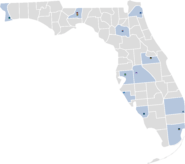Florida A&M University
|
FAMU | |
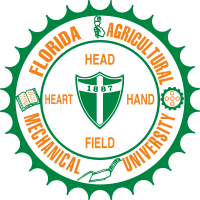 | |
Former names |
Florida Agricultural and Mechanical College for Negroes (1909–1953) State Normal and Industrial College for Colored Students (1891–1909) State Normal College for Colored Students (1887–1891) |
|---|---|
| Motto | Excellence With Caring |
| Type |
Public, HBCU Land-grant |
| Established | October 3, 1887 |
| Endowment | $113.1 million (2016)[1] |
| President | Larry Robinson (chemist) |
Academic staff | 630 |
| Students | 9,614[2] |
| Location |
Tallahassee, Florida, U.S. 30°25′04″N 84°17′04″W / 30.4178°N 84.2845°WCoordinates: 30°25′04″N 84°17′04″W / 30.4178°N 84.2845°W |
| Campus |
Urban 422 acres (1.7 km2)[3] |
| Colors |
Orange and Green |
| Athletics | NCAA Division I – MEAC |
| Nickname | Rattlers and Lady Rattlers |
| Affiliations |
State University System of Florida Urban 13 APLU TMCF |
| Mascot | Venom the Rattlesnake |
| Website |
www |
|
| |
Florida Agricultural and Mechanical University (FAMU) is a public, historically black university in Tallahassee, Florida. Founded in 1887, it is located on the highest geographic hill in Tallahassee. It is the 5th largest historically black university in the United States by enrollment and the only public historically black university in Florida.[4] It is a member institution of the State University System of Florida, as well as one of the state's land grant universities, and is accredited to award baccalaureate, master's and doctoral degrees by the Commission on Colleges of the Southern Association of Colleges and Schools. The university is a member-school of the Thurgood Marshall College Fund.
The 2018 edition of the U.S. News & World Report college rankings placed the university 207th among 223 tier one "national universities", 6th among all HBCUs, and 1st among all public HBCUs.[5] The university is classified as the second tier R2: Doctoral University - Higher Research Activity in the Carnegie Classifications by the Carnegie Foundation for the Advancement of Teaching.[6] In 2015, the National Science Foundation ranked Florida A&M University as the #1 HBCU in the nation for total research and development expenditures.[7]
FAMU sports teams are known as the "Rattlers", and compete in Division I of the NCAA. They are a member of the Mid-Eastern Athletic Conference (MEAC).
History
The introduction of legislation leading to the foundation of the college was due to the initiative of the Superintendent of Public Instruction, the abolitionist Jonathan C. Gibbs. The date also reflects the new Florida Constitution of 1885, which prohibited racial integration in schools. The College was located in Tallahassee because Leon County and adjacent counties led the state in African-American population, reflecting Tallahassee's former status as the center of Florida's slave trade. (See History of Tallahassee, Florida#Black history.) The site of the university is the 375-acre slave plantation[8] :94 of Florida Governor William Pope Duval, whose mansion, today the site of the Carnegie Library, burned in 1905.

On October 3, 1887, the State Normal College for Colored Students began classes, and became a land-grant college four years later when it received $7,500 under the Second Morrill Act, and its name was changed to State Normal and Industrial College for Colored Students. However, it was not an official institution of higher learning until the 1905 Buckman Act, which transferred control from the Department of Education to the Board of Control, creating what was the foundation for the modern Florida A&M University. This same act is responsible for the creation of the University of Florida and Florida State University from their previous institutions. In 1909, the name of the college was once again changed, to Florida Agricultural and Mechanical College for Negroes, and in 1953 the name was finally changed to Florida Agricultural and Mechanical University. Florida A&M is the only publicly funded historically black college or university in the state of Florida.[9]
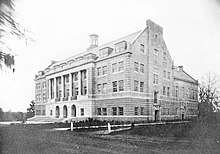
In 1951, the university started a pharmacy and nursing program. In order to give these students hands-on experience, the university built a hospital. Until 1971 Florida A&M Hospital was the only one within 150 miles (240 km) of Tallahassee to serve African Americans.[10][11] It closed in 1971, after then-Tallahassee Memorial Hospital started serving African Americans.
In 1963, FAMU students demonstrated against segregation in the city.[12]
In 1992, 1995, and 1997, FAMU successfully recruited more National Achievement Scholars than Harvard.[13][14][15]
In the fall of 1997, FAMU was selected as the TIME Magazine-Princeton Review "College of the Year" and was cited in 1999 by Black Issues in Higher Education for awarding more baccalaureate degrees to African-Americans than any institutions in the nation.[16][17]
In 2017, FAMU became the first university to launch an African-American news network through its School of Journalism and Graphic Communications. The network is named "The Black Television News Channel" and is accompanied by a multimillion-dollar, media-training center for aspiring journalists. This network is expected to bring $30 million annually in economic stimulus to the Tallahassee region.[18]
Presidents
- Thomas DeSaille Tucker 1887–1901
- Nathan B. Young 1901–1923
- William A. Howard 1923–1924
- John Robert Edward Lee 1924–1944
- J.B. Bragg April 5, 1944 – September 1, 1944
- William H. Gray, Jr. 1944–1949
- H. Manning Efferson July 7, 1949 – April 1, 1950
- George W. Gore 1950–1968
- Benjamin L. Perry, Jr. 1968–1977
- Walter L. Smith 1977–1985
- Frederick S. Humphries 1985–2001
- Henry Lewis III January 2002 – June 2002
- Fred Gainous 2002–2004
- Castell V. Bryant January 2005 – May 2007
- James H. Ammons July 2, 2007 – July 16, 2012
- Elmira Mangum April 1, 2014 – September 15, 2016
- Larry Robinson November 30, 2017 – Present, May 2007 - July 2007, July 2012 – April 2014, September 2016 – November 2017
Academics
The university offers 56 bachelor's degrees. 29 master's degrees within 11 of the university's 13 schools and colleges. Two professional degrees and 12 doctoral degree programs are offered.[19]
Florida A&M has an honors program for high-achieving undergraduate students who meet the high performance criteria.[20]
In 2012, FAMU implemented the Medical Scholars Program (MSP). MSP is a rigious pre-medical program designed to uniquely prepare academically talented undergraduate students for success in medical school and beyond. There is a cap of 10 freshmen accepted into this competitive four-year program each year.[21]
As of 2018, FAMU leads the nation with eight championship titles in the Honda Campus All-Star Challenge (HCASC). The HCASC is an annual academic quiz bowl competition sponsored by Honda that is exclusive to the nation's HBCUs.[22]
FAMU has eight fully funded, endowed, eminent-scholars chairs, including two in the School of Journalism and Graphic Communications, four in the School of Business & Industry, one in the College of Education, one in Arts and Sciences, and one in its School of Pharmacy.[23]
Demographics
| Student Body[25] | Florida[26] | U.S. Census[27] | |
|---|---|---|---|
| African American | 83.4% | 16.7% | 13.2% |
| Asian American | 1.00% | 2.7% | 5.3% |
| Hispanic American (of any race) |
3.51% | 23.6% | 17.1% |
| International students | 0.81% | N/A | N/A |
| Native American | 0.08% | 0.5% | 1.2% |
| Non-Hispanic White | 8.13% | 56.4% | 62.6% |
Florida A&M University student enrollment population consists primarily of undergraduates. 84.1% of the school's enrolled students are African-American. The next largest demographic group is White (non-Hispanic) students at 7.71%. Native Americans, Hispanics and Asian Americans round out the remaining 8.19%.[28]
Accreditation
Florida A&M University has been accredited by Southern Association of Colleges and Schools (SACS) since 1935.[29]
Rankings
| University rankings | |
|---|---|
| National | |
| Forbes[30] | 645 [31] |
| U.S. News & World Report[32] | 207 [33] |
| Washington Monthly[34] | 103[35] |
In 2016, Essence and Money magazines ranked FAMU as the top HBCU and No. 5 among all national universities and colleges in their list of the "50 Best Colleges for African-Americans."[36]
FAMU's School of Architecture and Engineering Technology is consistently recognized as the No. 1 producer of African-American architects in the nation by Diverse Issues in Higher Education .[37]
New York-based financial technology company SmartAsset has ranked FAMU among the best value colleges (No. 4) and the top schools where graduates earn the highest starting salaries (No. 9). The rankings consider all Florida universities and colleges and are part of SmartAsset's overarching study of the schools providing students with the best overall value. The study considered starting salary, as well as scholarships and grants, tuition, living costs, and retention rate.[38]
The Princeton Review recently named FAMU among its "2016 Best Colleges: Region-by-Region" list, ranking FAMU as one of the "Best Southeastern" colleges and universities in the nation. FAMU is among only 140 colleges and universities in the Southeast that received this ranking. The Princeton Review notes that institutions making the list are considered academically outstanding and well worth consideration in a student's college search.[38]
The Washington Monthly College Guide placed FAMU among its list of the top 100 national universities.[38]
Niche, a ranking and reviews company aimed at helping high school students make the right college choice, listed FAMU among its "2016 Best Colleges." Niche's top-ranked colleges are elite academic institutions that provide a good value, attract a diverse student body, and offer an exceptional college experience.[38]
NerdWallet, a national personal finance and information service, recently released its "Florida's Best Colleges for Your Buck" list, ranking FAMU as one of the state's top schools for affordability and student success after graduation. NerdWallet cites that FAMU's offering of the lowest annual tuition among all of the colleges or universities on the list, and its ranking as one of the top HBCUs in the nation (U.S. News & World Report), make it "tough to beat." FAMU was also cited for graduating notable alumni, such as Microsoft chair John W. Thompson and U.S. Rep. Corrine Brown.[38]
FAMU was recognized in 2015 by the Building Green Initiative as the No. 2 "Greenest" public HBCU in the nation. In releasing its rankings, the initiative celebrated FAMU for its sustainability efforts via its agriculture and recycling programs, citing that the University has an "innovative approach to solving modern sustainability issues."[38]
Forbes magazine listed the University as one of "America's Top Colleges" for 2015, and as one of its "Best in the South" colleges. Also, College Choice named FAMU among its 2015 list of the Best HBCUs, and a recently released report by the National Science Foundation (NSF) listed FAMU as the No. 1 HBCU in the nation for total research and development (R&D) expenditures. Additionally, the American City Business Journals listed FAMU among the nation's top public universities and colleges.[31]
Between 2004 and 2013, FAMU was the second most baccalaureate-origin institution of U.S. black male doctorate recipients.[39]
In 2015, Florida A&M was ranked the No. 3 college in the United States by the Social Mobility Index college rankings.[40]
FAMU was named the number-one college for African Americans in the United States in the September 2006 issue of Black Enterprise Magazine and a "Best in the Southeast" college by Forbes Magazine in 2014.[41] FAMU is a member school of the Thurgood Marshall Scholarship Fund.[42]
College of Pharmacy and Pharmaceutical Sciences
The School of Pharmacy was organized in 1951. It received its present name in 1985 in recognition of the expanded role and mission of the college in professional and graduate education. It is now one of the largest colleges of pharmacy in the country.[43] It offers a Doctor of Pharmacy Degree (PharmD) and also a PhD program in Pharmacy. The fall PharmD enrollment was 1,068, and FAMU has produced over 20% of the nation's African-American pharmacists.[44] The Pharmacy School in 2009–2010 graduate student enrollment was 122, with 42 PhDs, 21 DrPH, 45 MPH and 14 MS candidates. The school has graduated over 60% of African-American PhDs in pharmaceutical sciences, since 1990.[44] In 2003 it was ranked third in the nation for research funding through the National Institute of Health and consistently ranks as one of the top-funded pharmacy school in the southeast.[45] It is accredited by the Accreditation Council for Pharmacy Education (ACPE).[46]
College of Engineering
College of Law
On December 21, 1949, a division of law was established at the then Florida A&M College, and the first class was admitted in 1951. The legislature established the school because no "separate but equal" state-supported law school existed for African Americans at that time.[47] The school's enrollment was limited to African-American male students and was located in Tallahassee, Florida.[47] The FAMU law school was closed through a vote by the Florida legislature in 1965, with the funds transferred to a new law school at Florida State University; vindictiveness for FAMU activism in support of desegregation was a factor.[48] The College of Law reopened in 2002 and now occupies its own 160,000-square-foot (15,000 m2) building at 201 Beggs Avenue in downtown Orlando with an onsite College of Law Library that is open to the general public. The four-story building was designed by Rhodes+Brito Architects of Orlando. The new building opened to students in 2005. Of the 1,807 who applied to the school in 2009, 630 were accepted and 234 enrolled.[47][49] Seventy-seven percent of the entering class were Florida residents, and 42% were non-minority students. The FAMU College of Law recently announced that 72.2 percent of its first-time examinees passed the February 2014 Florida Bar Exam. The Florida Bar Exam first-time cumulative pass rate for February 2014 was 72.9 percent.[50]
Research
FAMU's annual research funding currently exceeds $54 million. Research is funded by grants from the National Oceanic and Atmospheric Administration, the National Science Foundation and the National Institutes of Health.[51] For 2007–2008, the largest source of funds was $15.1 million from the US Department of Education, followed by $6.1 million from the Department of Agriculture (most of which is allocated to FAMU by virtue of it being a land grant university.) [52] FAMU's two largest research areas are agriculture and health sciences.[52] The Pharmacy College's research funding for 2009–2010 is $22.5 million ($21.0 million in federal, $1.1 million in state support, and from $325,046 private industry support) with over $37,301,715 committed through 2012.[44]
Campus
FAMU's main campus is in Tallahassee, Florida, just south of the State Capitol and the campus of Florida State University. It also has a law school campus in Orlando, Florida and the Research and Development Center in Quincy, Florida. The College of Pharmacy has extension campuses in Miami, Jacksonville, Tampa and Crestview, Florida.[43]
Residential facilities
FAMU requires all first-year students to live on campus, if their families are over 35 miles (56 km) from the FAMU campus. Exceptions to this rule include married students, students with dependents, and students who are of age 21 by the start of classes.[53]
FAMU offers a limited number of rooms for students with dependent families.[53] Family households may occupy rooms in the Palmetto North Apartments.[54] Residents are zoned to Leon County Schools.[55] Residents are zoned to Bond Elementary School,[56] Nims Middle School,[57] and Leon High School.[58]
National historic district
|
Florida Agricultural and Mechanical College Historic District | |
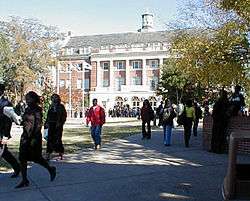 FAMU campus, Lee Hall | |
  | |
| Location | Tallahassee, Florida |
|---|---|
| Area | 370 acres (1.5 km2) |
| Built | 1907 |
| Architect | William Augustus Edwards; Rudolph Weaver, et al. |
| Architectural style | Colonial Revival, Classical Revival |
| NRHP reference # | 96000530[59] |
| Added to NRHP | May 9, 1996 |
The Florida A&M Tallahassee Campus consists of 132 buildings spread across 420 acres (1.7 km2). Part of the campus is listed on the U.S. National Register of Historic Places as the Florida Agricultural and Mechanical College Historic District. It received that designation on May 9, 1996. The district is centered along the section of Martin Luther King Boulevard that goes through the campus. According to the National Register, it covers 370 acres (1.5 km2), and contains 14 historic buildings and 1 object. One campus building, the old Carnegie Library, is listed separately on the National Register.[59] On April 18, 2012, the AIA's Florida Chapter placed Lee Hall at Florida Agricultural & Mechanical University (FAMU) on its list of Florida Architecture: 100 Years. 100 Places.[60]
Research Centers
The FAMU Research and Development Center in Quincy, Florida serves students in animal science, pre-veterinary medicine and veterinary technology. In May 2009, a new New Animal Healthcare Complex opened to support FAMU's pre-veterinary program. The complex was funded by a $1.2 million grant from the United States Department of Agriculture (USDA) Cooperative Extension Research.[61]
Other research centers include the following:[23]
- The Sustainability Institute
- The Center for Viticulture and Small Fruit Research
- The Center for Plasma Science and Technology
Libraries
The Samuel H. Coleman Memorial Library is the University's main library, named for the man who served as the University's general alumni president for 14 years. After the University's main building containing administrative offices, cafeteria, and library were destroyed by fire, Andrew Carnegie donated a $10,000 gift for the construction of a new library facility. The construction of Coleman Library began during the post-World War II era. The new library was officially dedicated during FAMU's 1949 annual Founders Day celebration in honor of civil leader Samuel H. Coleman.[62] The library was built in 1948, renovated in 1972, expanded in 1990 and again in 2004. The 88,964 square feet (8,265.0 m2) facility includes study rooms, a student study lounge and cafe, graduate and faculty study carrels, teleconference rooms, and a state-of-the-art information literacy classroom.[63]
Along with the additional 20,000 square feet (1,900 m2) available in the branch libraries, the Florida A&M University Libraries provide a seating capacity of 920. The Libraries hold nearly 2 million volumes, over 155,000 e-books and e-journals, and 256,126 microforms, which are readily accessible to users and support both onsite and online programs.[63]
Carnegie Library
In 1907, when the city of Tallahassee turned down philanthropist Andrew Carnegie's offer of a library building, because by his rules it would have had to serve black patrons, Carnegie funded instead the Carnegie Library at FAMU. It no longer serves as a library, but instead houses the Southeastern Regional Black Archives Research Center and Museum.
Athletics
Florida A&M University is a member of the Mid-Eastern Athletic Conference and participates in NCAA Division I-AA. FAMU's sports teams are called the "Rattlers." FAMU offers men's sports in baseball, basketball, football, golf, swimming, tennis and track and field. It offers women's sports in basketball, bowling, softball, swimming, wrestling, tennis, track and field and volleyball.[64]
From 1938 to 1961, the football team won the Black College National Championship eight times, including six times under head coach Jake Gaither, in 1950, 1952, 1954, 1957, 1959 and 1961. When Gaither retired after 25 years of coaching in 1969, his FAMU teams had a 203-36-4 (wins-losses-ties) record, for a .844 winning percentage. Thirty-six players from Gaither's teams were All-Americans, and 42 went on to play in the National Football League. During his 25 years as head coach, FAMU won 22 Southern Intercollegiate Athletic Conference championships. Gaither was elected to the College Football Hall of Fame in 1975. FAMU went on to win the first NCAA D1-AA National Championship in 1978 after defeating the University of Massachusetts Amherst.
The men's basketball team has qualified for the opening round game of the NCAA men's basketball tournament three times (1999, 2004 and 2007). The FAMU Wrestling Team placed third in their region and had several national placers in 2008 under Coach Sharif.
Student life
FAMU is one of the largest HBCUs in the nation with a student body of nearly 10,000 students hailing from all regions of the United States and several foreign countries. Individuals part of the FAMU community are affectionately referred to as "FAMU-ly" or members of "Rattler Nation".[65][66]
Gospel Choir
The FAMU Gospel Choir was established in 1957.
Reserve Officers Training Corps
FAMU is home to both Army ROTC and Naval ROTC units, permitting students to pursue careers as commissioned officers in the U.S. Army, U.S. Navy, and U.S. Marine Corps, upon graduation. For those FAMU students desiring to become commissioned officers in the U.S. Air Force, a cross-campus arrangement permits their taking Air Force ROTC training with the AFROTC detachment at nearby Florida State University (FSU). Likewise, FSU students desiring to become Navy and Marine Corps officers may also enroll with FAMU's NROTC unit under a similar arrangement.
Marching band
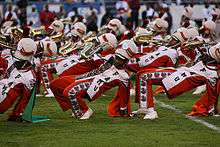
The FAMU marching band, The Marching 100, received national recognition in January 1993 when it performed in the 42nd Presidential Inauguration Parade by invitation of Bill Clinton. The band has also performed in the Super Bowl and in the 44th Presidential Inauguration Parade for Barack Obama.
Student Media
- The FAMUAN – The student newspaper[67]
- Journey Magazine – The student magazine[68]
- FAMU 20 TV – The FAMU TV news broadcast network[69]
- WANM 90.5 FM – The university owned and operated radio station.[70]
See also
References
- ↑ "U.S. and Canadian Institutions Listed by Fiscal Year 2016 Market Value of Endow" (PDF). NACUBO. Archived from the original (PDF) on 2017-02-15. Retrieved 24 March 2017.
- ↑ "Office of Institutional Research - Florida Agricultural and Mechanical University 2016".
- ↑ "About FAMU - Florida Agricultural and Mechanical University 2018". www.famu.edu. line feed character in
|title=at position 14 (help) - ↑ "Largest Historically Black Colleges (PHOTOS)". The Huffington Post. Retrieved 29 July 2015.
- ↑ "Archived copy". Archived from the original on 2016-10-27. Retrieved 2017-09-15.
- ↑ Rattler, Big (12 January 2016). "Rattler Nation: FAMU climbs to R2, second highest research category in Carnegie Classifications".
- ↑ "FAMU is Top HBCU for Research and Development | FAMU Forward". Famunews.com. 2015-08-27. Retrieved 2015-09-22.
- ↑ Federal Writers' Project (1993). McDonogh, Gary W., ed. The Florida Negro. A Federal Writers' Project Legacy. University Press of Mississippi. ISBN 0878055886.
- ↑ "About Florida Agricultural and Mechanical University". Florida Agriculture and Mechanical University. Retrieved 6 May 2014.
- ↑ "FAMU Hospital". floridamemory.com. Retrieved February 14, 2014.
- ↑ "News Headlines - Florida Agricultural and Mechanical University 2015". Famu.edu. 2006-12-07. Retrieved 2015-09-22.
- ↑ Pillow, Travis (November 9, 2013). "Senator recalls role in protest". Florida Today. Melbourne, Florida. pp. 10B. Retrieved November 11, 2013.
- ↑ "Phenomenal growth – Black Issues in Higher Education's sixth annual Top 100 rankings of minority baccalaureates – Cover Story". Retrieved 29 July 2015.
- ↑ "Famu Gets Most Talented Black Scholars - tribunedigital-sunsentinel". Articles.sun-sentinel.com. 1996-01-12. Retrieved 2015-09-22.
- ↑ Rose (January 25, 1998). "Ongoing Famu Excellence - tribunedigital-orlandosentinel". Articles.orlandosentinel.com. Retrieved 2015-09-22.
- ↑ "CNN - Time survey names Florida A&M 'College of the Year' - Aug. 24, 1997". Retrieved 29 July 2015.
- ↑ "About FAMU - Florida Agricultural and Mechanical University 2015". Retrieved 29 July 2015.
- ↑ "Black news channel to launch in 2018, organizers say". tallahassee.com.
- ↑ "Academics - Florida Agricultural and Mechanical University 2018". www.famu.edu. line feed character in
|title=at position 13 (help) - ↑ "Department of Honors Program - Florida Agricultural and Mechanical University 2016".
- ↑ "Medical Scholars Program - Florida Agricultural and Mechanical University 2016".
- ↑ "FAMU's academic team brings prestige, cash to the university".
- 1 2 "About FAMU - Florida Agricultural and Mechanical University 2016".
- ↑ http://www.famu.edu/oir/UserFiles/File/DataReporting/FactBooks/1617/Student%20Enrollment%202016-17.pdf
- ↑ "Population estimates, July 1, 2015, (V2015)".
- ↑ "Florida QuickFacts from the US Census Bureau". census.gov. Archived from the original on 2012-08-14.
- ↑ "USA QuickFacts from the US Census Bureau". census.gov.
- ↑ "Enrollment Summary, 2016–2017 factbook" (PDF). FAMU. Retrieved 2017-10-26.
- ↑ Gary Finout (December 11, 2012). "Scandals threaten FAMU's accreditation". Associated Press. Archived from the original on December 19, 2012. Retrieved December 19, 2012.
- ↑ "America's Top Colleges". Forbes. July 5, 2016.
- 1 2 "Florida Agricultural and Mechanical University".
- ↑ "Best Colleges 2017: National Universities Rankings". U.S. News & World Report. September 12, 2016.
- ↑ https://www.usnews.com/best-colleges/famu-1480
- ↑ "2016 Rankings - National Universities". Washington Monthly. Retrieved September 6, 2016.
- ↑ "2017 National Universities Rankings". Washington Monthly. n.d. Retrieved October 23, 2017. r SMI = 4
- ↑ "FAMU ranked No. 1 HBCU in Essence/Money magazine report".
- ↑ Education, Diverse Issues in Higher. "Top 100 Bachelor's Degree Producers". Archived from the original on 2016-08-14. Retrieved 2016-08-06.
- 1 2 3 4 5 6 "FAMU Receives Top Honors from Ranking Organizations". 5 November 2015.
- ↑ http://www.morehouse.edu/about/pdf/Morehouse-Facts-2014.pdf
- ↑ CollegeNET. "Social Mobility Index". Retrieved 29 July 2015.
- ↑ "About FAMU - Florida Agricultural and Mechanical University 2015". Retrieved 29 July 2015.
- ↑ Mauro Catenacci. "About Historically Black Colleges And Universities (HBCUS) - Thurgood Marshall College Fund - Thurgood Marshall College Fund". Retrieved 29 July 2015.
- 1 2 "Overview". Archived from the original on 2010-06-09. Retrieved 2009-12-31.
- 1 2 3 "Fact Sheet". Archived from the original on 2010-06-09. Retrieved 2009-12-31.
- ↑ "NIH Rankings". Archived from the original on 2010-11-04. Retrieved 2010-03-01.
- ↑ Pharmacy, FAMU. "Accreditation". pharmacy.famu.edu.
- 1 2 3 Kay, Julie (Jan 1, 2010). "Saving the School". American Bar Association Journal. Retrieved 2009-12-31.
- ↑ Haughney, Kathleen; Deslatte, Aaron (December 24, 2011). "Scott, FAMU rift only the latest incident in rocky 50-year relationship", (Fort Lauderdale)". Sun-Sentinel. Retrieved July 4, 2015.
- ↑ "1L Class Profile". Archived from the original on 2010-02-03. Retrieved 2009-12-31.
- ↑ "News Headlines - Florida Agricultural and Mechanical University 2015". Famu.edu. 2006-12-07. Retrieved 2015-09-22.
- ↑ "Page not found on the university website". Retrieved 29 July 2015.
- 1 2 "Summary of Federal Contracts & Grants Awards Listed by Federal Sponsoring Agency" (PDF). Retrieved 2009-12-31.
- 1 2 "Frequently Asked Questions." Florida A&M University. Retrieved on October 2, 2011.
- ↑ Mitchell, Marri (March 17, 2010). "Families find housing on campus". thefamuanonline.com. Archived from the original on April 4, 2012. Retrieved October 2, 2011.
- ↑ "Campus Map." Florida A&M University. Retrieved on October 2, 2011. Palmetto North consists of buildings 152 to 160, in the lower right area of the map.
- ↑ "Leon County Elementary School Zoning 2009–2010 School Year Archived 2014-05-18 at WebCite." Leon County Schools. Retrieved on August 15, 2011.
- ↑ "Leon County Middle School Zoning 2009–2010 School Year Archived 2014-05-18 at WebCite." Leon County Schools. Retrieved on August 15, 2011.
- ↑ "Leon County High School Zonin" (PDF). Leon County Schools. Archived from the original (PDF) on May 18, 2014. Retrieved August 15, 2011.
- 1 2 National Park Service (2007-01-23). "National Register Information System". National Register of Historic Places. National Park Service.
- ↑ "Florida Architecture: 100 Years. 100 Places". THE FLORIDA ASSOCIATION OF THE AMERICAN INSTITUTE OF ARCHITECTS. Retrieved 27 April 2012.
- ↑ "Ribbon-Cutting for New Animal Healthcare Complex". Retrieved 2009-12-31.
- ↑ Guthrie, Ana (2012). "The History of Florida's Four FBCU (Historically Black Colleges & Universities) Libraries". Florida Libraries. 55 (2): 41.
- 1 2 "FAMU Libraries: About Us". FAMU Libraries. Retrieved 30 October 2015.
- ↑ "Official Website for FAMU Athletics". Archived from the original on 2010-01-05. Retrieved 2009-12-31.
- ↑ "About Us".
- ↑ "Rattler Nation".
- ↑ "Florida A&M (thefamuanonline) News and Classifieds". www.thefamuanonline.com.
- ↑ "Journey Magazine – Florida A&M University's Campus Magazine". jmagonline.com.
- ↑ "Arizona's Top Daycare, Locksmith, and Manufacturer Reviews". famutvnews.com.
- ↑ "Student Media". 8 October 2013.
External links
![]()
